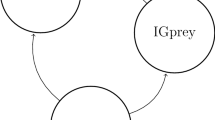Abstract
The structure and dynamics of food webs are largely dependent upon interactions among consumers and their resources. However, interspecific interactions such as intraguild predation and interference competition can also play a significant role in the stability of communities. The role of antagonistic/synergistic interactions among predators has been largely ignored in food web theory. These mechanisms influence predation rates, which is one of the key factors regulating food web structure and dynamics, thus ignoring them can potentially limit understanding of food webs. Using nonlinear models, it is shown that critical aspects of multiple predator food web dynamics are antagonistic/synergistic interactions among predators. The influence of antagonistic/synergistic interactions on coexistence of predators depended largely upon the parameter set used and the degree of feeding niche differentiation. In all cases when there was no effect of antagonism or synergism (a ij =1.00), the predators coexisted. Using the stable parameter set, coexistence occurred across the range of antagonism/synergism used. However, using the chaotic parameter strong antagonism resulted in the extinction of one or both species, while strong synergism tended to coexistence. Whereas using the limit cycle parameter set, coexistence was strongly dependent on the degree of feeding niche overlap. Additionally increasing the degree of feeding specialization of the predators on the two prey species increased the amount of parameter space in which coexistence of the two predators occurred. Bifurcation analyses supported the general pattern of increased stability when the predator interaction was synergistic and decreased stability when it was antagonistic. Thus, synergistic interactions should be more common than antagonistic interactions in ecological systems.
Similar content being viewed by others
References
Abrams, P.A., 1999. The adaptive dynamics of consumer choice. Am. Nat. 153, 83–97.
Bjorkman, C., Liman, A.S., 2005. Foraging behaviour influences the outcome of predator–predator interactions. Ecol. Entomol. 30, 164–169.
Bolker, B., Holyoak, M.A., Krivan, V., Rowe, L., Schmitz, O., 2003. Connecting theoretical and empirical studies of trait-mediated interactions. Ecology 84, 1101–1114.
Cowan, C.A., Peckarsky, B.L., 1994. Diel feeding and positioning periodicity of a grazing mayfly in a trout stream and a fishless stream. Can. J. Fish. Aquat. Sci. 51, 450–459.
Elton, C.S., 1958. The Ecology of Invasions by Animals and Plants. University of Chicago Press, Chicago.
Hastings, A., Powell, T., 1991. Chaos in a three species food chain model. Ecology 72, 896–903.
Huxel, G.R., McCann, K., 1998. Food web stability: the influence of trophic flows across habitats. Am. Nat. 152, 460–469.
Huxel, G.R., McCann, K., Polis, G.A., 2002. The effect of partitioning of allochthonous and autochthonous resources on food web stability. Ecol. Res. 17, 419–435.
May, R.M., 1973. Stability and complexity in model ecosystems. Princeton University Press, Princeton.
McCann, K., Hastings, A., 1997. Re-evaluating the omnivory-stability relationship in food webs. Proc. Roy. Soc. Lond. B 264, 1249–1254.
McCann, K., Hastings, A., Huxel, G.R., 1998. Weak trophic interactions and the balance of nature. Nature 395, 794–798.
McCann, K., Yodzis, P., 1994. Nonlinear dynamics and population disappearances. Am. Nat. 144, 873–879.
McPeek, M.A., 1990. Behavioral differences between Enallagma species (Odonata) influencing differential vulnerability to predators. Ecology 71, 1714–1726.
Polis, G.A., Holt, R.D., 1992. Intraguild predation: the dynamics of complex trophic interactions. TREE 7, 151–154.
Polis, G.A., Myers, C.A., Holt, R.D., 1989. The ecology and evolution of intraguild predation: potential competitors that eat each other. Annu. Rev. Ecol. Syst. 20, 297–330.
Polis, G.A., Strong, D.R., 1996. Food web complexity and community dynamics. Am. Nat. 147, 813–846.
Schmitz, O.J., Krivan, V., Ovadia, O., 2004. Trophic cascades: the primacy of trait-mediated indirect interactions. Ecol. Lett. 7, 153–163.
Schroeder, L.M., 1996. Interactions between the predators Thanasimus formicarius (Col: Cleridae) and Rhizophagus depressus (Col: Rhizophagidae), and the bark beetle Tomicus piniperda (Col: Scolytidae). Entomophaga 41, 63–75.
Sih, A., Crowley, P., McPeek, M., Petranka, J., Strohmeier, K., 1985. Predation, competition, and prey communities: A review of field experiments. Annu. Rev. Ecol. Syst. 16, 269–311.
Sih, A., Englund, G., Woorster, D., 1998. Emergent impacts of multiple predators on prey. TREE 13, 350–355.
Wilbur, H.M., Fauth, J.E., 1990. Experimental aquatic food webs: interactions between two predators and two prey. Am. Nat. 135, 176–204.
Wilson, D.S., Yoshimura, J., 1994. On the coexistence of specialists and generalists. Am. Nat. 144, 692–707.
Wootton, J.T., 1994. The nature and consequences of indirect effects in ecological communities. Annu. Rev. Ecol. Syst. 25, 443–466.
Yodzis, P., Innes, S., 1992. Body-size and consumer-resource dynamics. Am. Nat. 139, 1151–1175.
Author information
Authors and Affiliations
Corresponding author
Rights and permissions
About this article
Cite this article
Huxel, G.R. Antagonistic and Synergistic Interactions Among Predators. Bull. Math. Biol. 69, 2093–2104 (2007). https://doi.org/10.1007/s11538-007-9214-0
Received:
Accepted:
Published:
Issue Date:
DOI: https://doi.org/10.1007/s11538-007-9214-0




